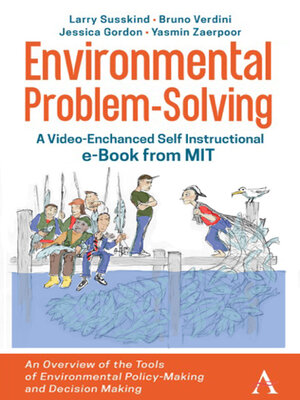Environmental Problem-Solving – a Video-Enhanced Self-Instructional e-Book from MIT
ebook ∣ An Overview of the Tools of Environmental Policy-Making and Decision-Making
By Lawrence Susskind

Sign up to save your library
With an OverDrive account, you can save your favorite libraries for at-a-glance information about availability. Find out more about OverDrive accounts.
Find this title in Libby, the library reading app by OverDrive.



Search for a digital library with this title
Title found at these libraries:
| Library Name | Distance |
|---|---|
| Loading... |
The 'Environmental Problem-Solving - A Video-Enhanced Self-Instructional e-Book from MIT' e-book presents short-excerpts from carefully selected readings, expert commentaries on those readings, interactive assignments, short videos of the best MIT student responses to the assignments, exam questions with excellent student responses and additional video excerpts of MIT faculty discussing the four main elements of the curriculum: models of environmental policy-making; competing theories of environmental ethics; tools for environmental assessment and environmental decision-making; and techniques for public engagement and group decision-making. The e-book covers the material presented in the semester-long course required of all students enrolled in MIT's Environmental Policy and Planning Specialization. It includes the actual assignments the MIT students are expected to complete each week as well as videos of the real-time oral presentations they are required to make to visiting practitioners. The final exam is accompanied by the best student answers.
|The book is divided into four sections: The first section focuses on how certain environmental problems can only be solved through active government effort to implement policies that effectively take science and politics into account. This section introduces readers to foundational concepts, including the steps in the US federal environmental policy-making process, and offers an action-oriented analysis of how environmental policy gets implemented and how practitioners can use comparative analysis of public policy in environmental problem-solving. It concludes with questions about the possibility of a unified theory of environmental policy making. The section empowers readers to develop, through exercises and videos, a solid framework to shape an action plan to solve specific environmental problems.
The next section focuses on formulating a sound philosophical basis for taking action in environmental problem solving situations. This includes a discussion of several ethical frameworks that practitioners can use to underpin the actions they propose. This section begins with a general overview of environmental ethics, and then moves on to a discussion of utilitarianism versus intrinsic value, deep green approaches to environmental problem-solving, the debate over sustainability versus economic growth, and how science and indigenous knowledge can be applied in a wide range of environmental problem-solving situations. The section, through exercises and videos, empowers readers to take a stand on these debates, drawing on practical cases with worked examples.
The penultimate section helps environmental practitioners understand how to use various analytical tools. It includes a quick survey of traditional and non-traditional evaluation tools, discussing the strengths and weaknesses of each tool, focusing on environmental impact assessment, cost benefit analysis, ecosystem services analysis, risk assessment, simulation and modeling, and scenario planning. The section, through interactive exercises and videos, empowers readers to practice multi-party environmental problem-solving, and to identify the power of each tool to enhance environmental problem-solving, developing the judgment to enumerate strengths and weaknesses as they see them playing out in practice.
The concluding section is a survey of the theory and practice behind mobilizing support for particular problem-solving ideas. It includes discussions of democratic decision-making and environmental problem solving, how the public can be brought in as a partner, methods of collaborative decision-making, the ideas of consensus building, and how politics...







